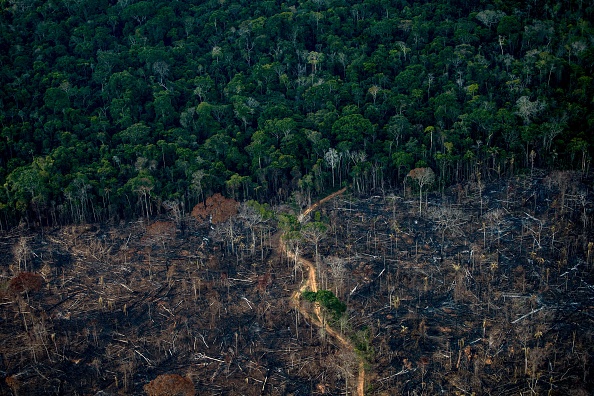Companies Urged to Take Stock of Their Impact on Nature and Related Risks
A U.N.-funded task force aims to help businesses report and act on a variety of issues, including deforestation and overfarming
Companies should consider the natural world as core to their business and report their effect on it in much more detail, according to a U.N.-funded group that promotes sustainable business practices. But assessing environmental impact remains tricky.
The latest draft framework published by the Taskforce on Nature-Related Financial Disclosures aims to help big businesses and financial institutions report and act on nature-related risks, covering issues including deforestation, pollution, water stress and overfarming. It follows previous drafts, with a final version slated to be published in September.
Depletion of resources and damage to rivers and forests should be seen as integral to firms’ operations, and not merely a matter of corporate responsibility, said Tony Goldner, the TNFD’s executive director. “We used to think of nature as an endless supplier of resources into our business practices,” he said. “We’re trying to shift the conversation around the nature of the relationship between nature and business.”
The final framework should give priority to the end result in natural areas, said Kat Bruce, founder and director of environmental-DNA startup NatureMetrics.
“Creating a baseline on the state of nature in…priority areas and then ongoing monitoring to track progress over time is key,” she said, noting that new technology allowed for collection of much more solid biodiversity data.
“We also need to focus on how effective company actions are to mitigate risks,” Ms. Bruce said. The current guidance is a “solid step,” she said. “But we must not stop there.”
The TNFD is a market-led initiative but funded by the United Nations. It brings together 40 corporate executives, including Deputy Environment Director Alexandre Capelli of French luxury-goods group LVMH Moët Hennessy Louis Vuitton SE; GSK PLC head of corporate responsibility Sarah Dyson; Renata Pollini, head of nature at Swiss cement maker Holcim Ltd.; and Koushik Chatterjee, chief financial officer at India’s Tata Steel Ltd.
Some $44 trillion of global economic value is moderately or highly dependent on nature, according to the World Economic Forum. The collapse of natural systems could wipe $2.7 trillion a year from the global economy by 2030, according to the World Bank.
Companies and shareholders should pay more attention to the material risk of natural degradation, Mr. Goldner said. “Dependency is the pathway to risk,” he said. “If you’re investing in a fast-growing agricultural company in an area where there is water stress, that should trigger questions,” he said.
“What does that tell the investor about the ability to keep growing at that same rate?”
The draft framework covers three areas that should be assessed by large companies and financial institutions: the use of land, freshwater and oceans; pollution and pollution removal; and resource use and replenishment. The framework highlights the potential use of bidirectional metrics, that is to say, positive effects as well as negative, Mr. Goldner said.
A fourth indicator, on climate change, is covered by a separate framework set out by the Taskforce on Climate-Related Financial Disclosures, or TCFD.
Companies’ effect on climate change is relatively simple to measure. Emissions can be calculated in metric tons, and companies use shared rules that enable comparisons between one business and another, even if reporting remains patchy and partly based on estimates.
But reaching “nature positive”—as the TNFD aims to achieve—is a more nebulous concept, Mr. Goldner acknowledged. “There’s some work to do reaching a consensus on what nature positive looks like,” he said. It would likely encompass a basket of metrics, rather than a single indicator, he added.
The TNFD’s draft comes after nations agreed on a new international framework that will oblige large corporations to show they are reducing their impact on the world’s natural life.
Public subsidies seen as harmful for biodiversity will be cut by $500 billion a year under the Global Biodiversity Framework, or GBF, reached at the United Nations’ COP15 conference on biodiversity in Montreal in December.
Under the GBF, governments between now and 2030 will introduce laws and policy measures requiring large companies to disclose and reduce the damage done to ecosystems from their operations, supply chains and portfolios. They will also be required to provide information to the public needed for more sustainable consumption.
A previous draft requirement for businesses to reduce their negative impact on the environment by at least half wasn’t included in the final agreement, which doesn’t specify the extent of the required actions. Nearly 200 countries signed on to the final agreement. The U.S. wasn’t an official participant.
The TNFD’s framework aims to help businesses align their reporting and actions to global policy goals, such as the GBF, the task force said. The draft framework includes sector-specific guidance for areas including agriculture, mining, energy and financial services.
Guidance for other industries, including textiles, will be released on a rolling basis over the coming months, the TNFD said.
 Copyright 2020, Dow Jones & Company, Inc. All Rights Reserved Worldwide. LEARN MORE
Copyright 2020, Dow Jones & Company, Inc. All Rights Reserved Worldwide. LEARN MORE
This stylish family home combines a classic palette and finishes with a flexible floorplan
Just 55 minutes from Sydney, make this your creative getaway located in the majestic Hawkesbury region.
The telltale signs of financial control are not always obvious at the start. Here’s how to guard against them
It can be insidious, its victims hard to spot and it happens at all levels of society. Men, women, young, old, poor, affluent — financial abuse victims come from all walks of life. We only have to look at the most high profile case in the world — Britney Spears — to see evidence.
Statistics reveal that the average victim is a woman in her 40s or 50s with little or no access to employment and poor health outcomes.
But an increasing number of Australians are falling victim to financial abuse. In Australia, more than 623,000 men and women were subjected to financial abuse in 2020 — that is one in 30 women, or one in 50 men, according to the Commonwealth Bank’s Cost of Financial Abuse in Australia report.
Put simply, financial abuse is a form of family violence which occurs when one person exploits or controls another person’s financial resources. It most commonly takes the shape of a victim having money withheld or controlled by a partner, a victim made liable for joint debts, or even a victim being prevented from being able to work or further their education.
For more stories like this, order your copy of Kanebridge Quarterly magazine here.
And it can happen to anyone, says financial wellness coach, Betsy Westcott, who states up to 40 percent of Australians will experience it or know someone who has experienced it.
“There was a lady I once saw from Mosman — a suburb which on the surface has all the trappings of wealth and prosperity,” Westcott recounts. “She drove a Range Rover and lived in a lovely house but after she and her husband had their first child, she was made redundant while on maternity leave and her husband told her ‘Don’t worry about a new role, I’ll look after everything.’
“It turned out she always had to ask her husband for money because she had no access to the household accounts and she had to account for every last cent she spent. In the end, when she tried to leave the marriage, their account had been drained and all the debt was in her name.
“It doesn’t matter whether you’re smart or educated, we all have vulnerabilities.”

But just because financial abuse is prevalent — and has become more so since the pandemic and the onset of the cost of living crisis with financial situations becoming more tenuous — it doesn’t mean you can’t safeguard against it.
Heidi Reid is the executive director of strategic engagement at Berry Street, a child and family services charity whose mission includes educating adults to build money management skills.
Reid says a money-smart education should start in early childhood to create a generation resilient to financial abuse.
“Financial literacy education can build knowledge, confidence and skills to help people make informed decisions and manage their finances and their future,” Reid says. “Financial literacy…is appropriate for people at any age and life stage, and many experts recommend introducing basic concepts to children and young people early on. By incorporating age-appropriate discussions and activities, children can develop a foundational understanding of money and financial principles.
“Parents, guardians, and educators can tailor these conversations to the individual child’s maturity level and experiences. The goal is to build a gradual understanding of financial concepts and responsible money management as children grow.”
Laura Higgins, senior executive of ASIC’s MoneySmart, says there are eight main financial abuse warnings signs to look out for in a partner.
1. Controlling access to common accounts
2. Not providing enough money for living expenses
3. Trying to prevent you from working or studying
4. Taking out debts in your name or exerting pressure on you to sign up for loans
5. Making you account for how you spend your money
6. Selling or threatening to sell property without permission
7. Hiding money from you
8. Making you feel like you’re financially incompetent
Westcott adds that financial abuse can look different at different stages of life, particularly for women, whose vulnerabilities change with the decades. In your 20s it can be a partner pressuring you to take a loan out in your name; in your 30s it can be a partner who encourages you not to return to work after the birth of a child; in your 40s it can be the removal of assets in your name so you are trapped in a relationship; in your 50s and beyond it can be vulnerability from poor super accumulation and job prospects.
But she warns it doesn’t just affect women.
“When it comes to men being the victim, it can generally (but not always) look a little different,” Westcott says. “Consider scenarios where a man is coerced into paying for things to sustain a certain lifestyle and messages of love mixed with guilt, like “If you loved me” type of threats. It’s generally more about being pressured to financially over commit and then sometimes being left with unpaid loans.
“And it’s even harder to see when it happens to men because society holds men accountable for finances and so under reporting is a big problem.”
Either way, experts agree the best way to protect yourself is to have good financial literacy.
“To protect yourself you should stay informed and actively involved in your financial matters, being aware of your income, expenses and assets,” Reid says. “Financial literacy education can build knowledge, confidence and skills to help people make informed decisions and manage their finances and their future.”
This stylish family home combines a classic palette and finishes with a flexible floorplan
Consumers are going to gravitate toward applications powered by the buzzy new technology, analyst Michael Wolf predicts























